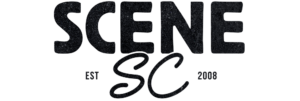Charleston locals, Human Resources, will officially release their debut album on May 20th and perform at King Dusko to celebrate. Guitarist Dries Vandenberg, bassist Aaron Utterbeck and drummer Matt Zutell actually began performing together after meeting their freshman year at Appalachian State University in the hills of North Carolina. Accompanied by two other friends at the time (Mark Cichonski and Jeremy Hachen), they were known as Donnie Dies and embodied a completely different progressive rock jam band style. Halfway through program though, Matt decided to finish his degree at the College of Charleston and transferred back to his hometown. Dries and Aaron later mirrored his move and joined him in the Holy City to breathe life into a new idea: Human Resources. Leaving behind their days of lengthy interludes and Dries’ similarly lengthy hair, they welcomed keyboardist Paul Chelmis and went into the studio.
SceneSC had the opportunity to sit down with drummer and Coast Records producer Matt Zutell to talk about their debut material, the recording process and the challenges that came with it.
Human Resources consists of well-versed musicians. How do you think the album showcases that? Can you provide any specific examples?
We actually made a very deliberate point to “do less” on this album as far as trying to “show off” our playing. It was a conscious decision to see how much of the fat we could trim. It’s like Paul Rudd says in Forgetting Sarah Marshall, “you’re doing too much, do less.” There’s truth to that. If each member’s part is quality, you don’t need a million parts or layers to make the song good. Dries, who can shred a fret board into a bonfire, doesn’t have any guitar solos on this album. That was a purposeful artistic decision we made. We did however, let Paul rip a couple synth solos on this record and they are awesome.
From a producer standpoint, what was the biggest challenge when working on En Route? How did you overcome it?
I think the biggest challenge when making an album is finally saying to yourself: it’s done. There is always the desire to continue to add or change things, or tinker with the mix, but at a certain point, you have to take heed of that good ol’ saying, “if it ain’t broke, don’t fix it.” When you’re listening to the same songs over and over, it can be easy to lose reference of what you’re hearing. Kind of like when you say the same word a million times, it loses all meaning. I think it’s important to work intensely, take a break, clear your head, and come back to it with fresh ears.
If you could have changed any one thing about the album, whether in regards to the process or artistic decisions, what would it have been and why?
To have finished it sooner. You really shouldn’t rush something like making an album and that’s why it was finished when it was finished, but we are already writing new material.
If you could have collaborated with any artist on the album, who would you have chosen?
Unfortunately, Julian Casablancas was busy (can’t believe he didn’t’ return my phone calls). Locally though, we’ve been all about Michael Flynn’s album “Face In The Clouds.” That dude is crazy talented.
What your personal favorite track on the album?
Restart. It’s dark yet dance-y.
What can your audience expect from an HR show? How do you hope they’ll be affected?
You can expect a live performance that sounds true to the recordings. We made sure not to over produce our album to the point where we couldn’t play it live. There’s nothing worse than listening to a record that sounds incredible and then going to see the artist perform it live, only to find yourself incredibly underwhelmed. We also never play the same set the same way. We always try to switch things up to keep it interesting and fresh each and every time we play. Through the use of projectors and our visual director, Marie Holder (who also sings on “Settled In”), we incorporate a visual element into our shows as well.



